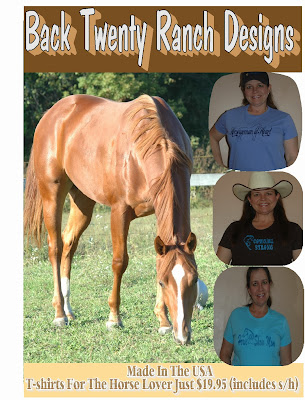Choke in horses is a very scarey thing . . . .
I have done my best to prevent choking in my horses by making sure that their hay flakes are always shook out, that they always have fresh water, and that any treats I feed (including baby carrots) are broken in pieces small enough to prevent choking. I'm also a nut about checking hay for any foreign bodies like paper, plastic, and even the little chopped pieces of baler twine that falls onto bales after the knotter has tied off.
Despite my precautions I almost lost Joey, are 7-year-old AQHA gelding. If I had it would I have blamed myself for feeding him a handful of alfalfa pellets . . . .
I have never been an advocate for feeding hay alternatives like cubes for the simple fact of the choking hazard they pose . . . even if you soak them like you should ALWAYS do. I have felt pretty comfortable feeding pelleted timothy and alfalfa and do so usually in a handful amount in outdoor feeders when I don't want my horses dropping hay in their dry lots after a hard rain. I have also mixed them in with a couple of handfuls of senior feed for our 24-year-old gelding . . . on days when it's really cold out . . . for a mid-day snack along with his hay.
So when I decided to give Joey a handful of these last night, instead of a new low-carb grain I had been feeding him (which despite claiming to be low carb/starch smelled very sweet and had made Joey - who's already a high-strung animal, very hyper), I wasn't concerned about there being a problem. He usually gets a handful or two a day in his stall or run-in, anyway, and I had never had any issues with him eating pelleted feed.
I thought hay pellets were a good idea instead of grain and in the interim while I looked for another grain alternative for him. I added his regular 1/4 oz of biotin, 1 oz scoop of bran, and 2 oz of ground flax and added a little warm water to get the supplements to stick to the pellets.
You can only image my horror when 5 minutes later he was thrashing around the stall and appeared to not be breathing very well. I knew it couldn't be colic . . . . Fortunately I have read about choke and did what I could. I aggressively massaged Joey's throatlatch and upper neck area where the esophagus is located. I did this for about 5-6 minutes. When I saw some relief and he started to breathe more normally and chewed some, I administered a full dose of Banamine.
Within 10 minutes Joey was back to normal and resumed eating his evening hay.
Lesson Learned: You can never be too careful. I fault wetting the pellets, however, this is what you are supposed to do when feeding them to horses that have poor teeth. I would now warn anyone who wets their pelleted hay pellets to make sure they have fully dissolved, which could take up to 20 minutes when soaked in warm water.
For me . . . I will probably NEVER feed anything more then a handful of pellets at a time and will scatter them in a feeder . . . . . NEVER again wetting them.
I was lucky and Joey was lucky that I always check my horses after they've been grained to make sure everything's OK and that they are eating a drinking normally.
Thursday, November 14, 2013
Friday, November 1, 2013
Prepare Now For Winter Mud
We just got three inches of rain in 24- hours. You would think my pens would be mud pits, but they're not. I attribute this to my being diligent about picking up manure daily and raking up any uneaten hay.
I've also learned that if you don't stay on top of these two tasks you'll regret it once we get into the winter.
Here are some other tips for keeping mud under control in your pens:
I've also learned that if you don't stay on top of these two tasks you'll regret it once we get into the winter.
Here are some other tips for keeping mud under control in your pens:
- Don't feed hay in pens, or if you do: feed only your best hay. When horses eat all of the hay it won't get mixed in the dirt, which contributes to mud.
- Consider feeding hay pellets in pens; horses don't waste these.
- Position your feeders on the highest spot possible in a pen (this will help drainage away from the spot) and move periodically (this will give the spot a rest).
- Pick up manure daily. Manure mixed with dirt instantly creates mud when it rains.
- Clean up hay and other bedding that gets drug out of run-in stalls into outdoor lots.
- Create drainage pits in your pens and fill with sand in any other low spots (in front of doors and gates).
- Monitor eating patterns. We have a horse that likes to push his hay to the run-in opening and then outside. Moving his hay to another spot in the run-in shed prevents him from rolling it outside and into the lot where it mixes with the dirt.
Subscribe to:
Posts (Atom)
